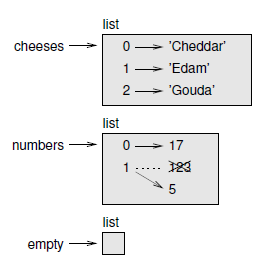The syntax for accessing the elements of a list is the same as for accessing the characters of a string—the bracket operator. The expression inside the brackets specifies the index. Remember that the indices start at 0:
>>> print cheeses[0]Cheddar

Unlike strings, lists are mutable. When the bracket operator appears on the left side of an assignment, it identifies the element of the list that will be assigned.
>>> numbers = [17, 123]>>> numbers[1] = 5>>> print numbers[17, 5]
The one-eth element of numbers, which used to be 123, is now 5.
You can think of a list as a relationship between indices and elements. This relationship is called a mapping; each index “maps to” one of the elements. Figure 10.1 shows the state diagram for cheeses, numbers and empty:
Lists are represented by boxes with the word “list” outside and the elements of the list inside. cheeses refers to a list with three elements indexed 0, 1 and 2. numbers contains two elements; the diagram shows that the value of the second element has been reassigned from 123 to 5. empty refers to a list with no elements.
List indices work the same way as string indices:
- Any integer expression can be used as an index.
- If you try to read or write an element that does not exist, you get an IndexError.
- If an index has a negative value, it counts backward from the end of the list.
The in operator also works on lists.
>>> cheeses = ['Cheddar', 'Edam', 'Gouda']>>> 'Edam' in cheesesTrue>>> 'Brie' in cheesesFalse
- 2940 reads






